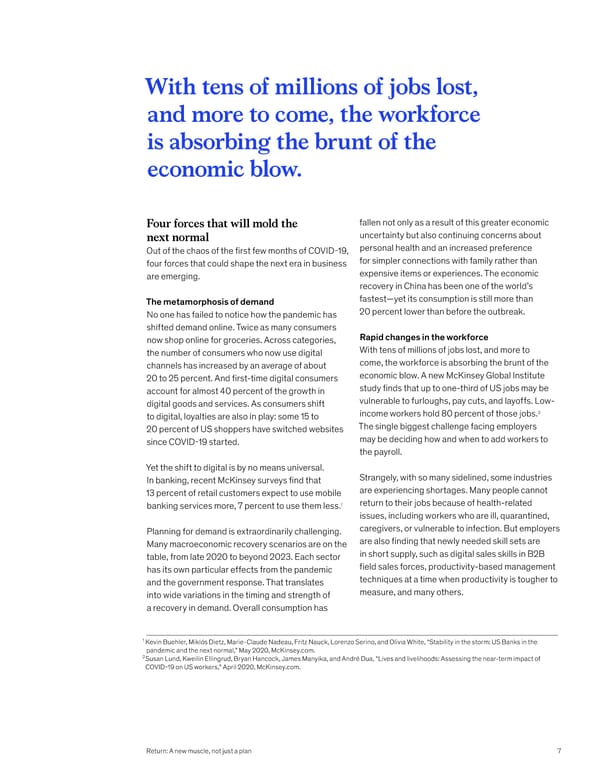With tens of millions of jobs lost, and more to come, the workforce is absorbing the brunt of the economic blow. Four forces that will mold the fallen not only as a result of this greater economic next normal uncertainty but also continuing concerns about Out of the chaos of the first few months of COVID-19, personal health and an increased preference four forces that could shape the next era in business for simpler connections with family rather than are emerging. expensive items or experiences. The economic recovery in China has been one of the world’s The metamorphosis of demand fastest—yet its consumption is still more than No one has failed to notice how the pandemic has 20 percent lower than before the outbreak. shifted demand online. Twice as many consumers now shop online for groceries. Across categories, Rapid changes in the workforce the number of consumers who now use digital With tens of millions of jobs lost, and more to channels has increased by an average of about come, the workforce is absorbing the brunt of the 20 to 25 percent. And first-time digital consumers economic blow. A new McKinsey Global Institute account for almost 40 percent of the growth in study finds that up to one-third of US jobs may be digital goods and services. As consumers shift vulnerable to furloughs, pay cuts, and layoffs. Low- income workers hold 80 percent of those jobs.2 to digital, loyalties are also in play: some 15 to 20 percent of US shoppers have switched websites The single biggest challenge facing employers since COVID-19 started. may be deciding how and when to add workers to the payroll. Yet the shift to digital is by no means universal. In banking, recent McKinsey surveys find that Strangely, with so many sidelined, some industries 13 percent of retail customers expect to use mobile are experiencing shortages. Many people cannot banking services more, 7 percent to use them less.1 return to their jobs because of health-related issues, including workers who are ill, quarantined, Planning for demand is extraordinarily challenging. caregivers, or vulnerable to infection. But employers Many macroeconomic recovery scenarios are on the are also finding that newly needed skill sets are table, from late 2020 to beyond 2023. Each sector in short supply, such as digital sales skills in B2B has its own particular effects from the pandemic field sales forces, productivity-based management and the government response. That translates techniques at a time when productivity is tougher to into wide variations in the timing and strength of measure, and many others. a recovery in demand. Overall consumption has 1 Kevin Buehler, Miklós Dietz, Marie-Claude Nadeau, Fritz Nauck, Lorenzo Serino, and Olivia White, “Stability in the storm: US Banks in the pandemic and the next normal,” May 2020, McKinsey.com. 2 Susan Lund, Kweilin Ellingrud, Bryan Hancock, James Manyika, and André Dua, “Lives and livelihoods: Assessing the near-term impact of COVID-19 on US workers,” April 2020, McKinsey.com. Return: A new muscle, not just a plan 7
 What Now? Page 8 Page 10
What Now? Page 8 Page 10